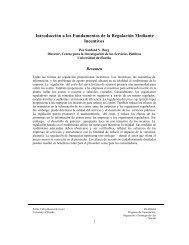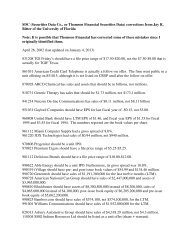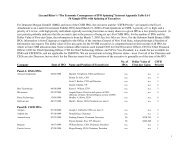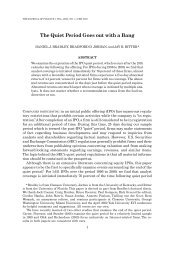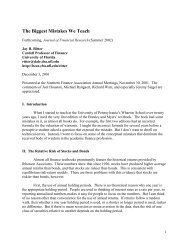Initial Public Offerings Jay R. Ritter Cordell Professor of Finance ...
Initial Public Offerings Jay R. Ritter Cordell Professor of Finance ...
Initial Public Offerings Jay R. Ritter Cordell Professor of Finance ...
Create successful ePaper yourself
Turn your PDF publications into a flip-book with our unique Google optimized e-Paper software.
6.4 Investor relations after going public<br />
The market price <strong>of</strong> a stock after going public is primarily determined by market<br />
conditions and the operating performance <strong>of</strong> the company. But there is also a role for an active<br />
investor relations program, and, everything else the same, the more analysts who follow the<br />
stock, the more potential buyers there will be. Thus, in choosing an underwriter, an important<br />
consideration for an issuing firm is that the underwriter has a well-respected analyst following<br />
the industry, who can be counted on to produce bullish research reports. These bullish research<br />
reports are especially important for creating demand when insiders are selling shares in the open<br />
market.<br />
7. Contractual Forms and the Going <strong>Public</strong> Process<br />
In the U.S., firms issuing stock use either a firm commitment or best efforts contract.<br />
With a firm commitment contract, a preliminary prospectus is issued containing a preliminary<br />
<strong>of</strong>fering price range. After the issuing firm and its investment banker have conducted a<br />
marketing campaign and acquired information about investors' willingness to purchase the issue,<br />
a final <strong>of</strong>fering price is set. The final prospectus is then issued, and when the S.E.C. clears the<br />
<strong>of</strong>fering, the IPO goes “effective”. The investment banker must sell all <strong>of</strong> the shares in the issue<br />
at a price no higher than the <strong>of</strong>fering price once this has been set.<br />
With a best efforts contract, the issuing firm and its investment banker agree on an <strong>of</strong>fer<br />
price as well as a minimum and maximum number <strong>of</strong> shares to be sold. A "selling period" then<br />
commences, during which the investment banker makes its "best efforts" to sell the shares to<br />
investors. If the minimum number <strong>of</strong> shares are not sold at the <strong>of</strong>fer price within a specified<br />
period <strong>of</strong> time, usually 90 days, the <strong>of</strong>fer is withdrawn and all investors' monies are refunded<br />
from an escrow account, with the issuing firm receiving no money. Best efforts <strong>of</strong>ferings are<br />
used almost exclusively by smaller, more speculative, issuers. Essentially all IPOs raising more<br />
than $10 million use firm commitment contracts.<br />
7.1 Bookbuilding<br />
Firm commitment <strong>of</strong>ferings in the U.S. use “book-building.” During and immediately<br />
after the road show period, the lead investment banker canvasses potential buyers and records<br />
who is interested in buying how much at what price. In other words, a demand curve is<br />
constructed. The <strong>of</strong>fering is then priced based upon this information. In contrast, in many<br />
countries (and in the U.S. with best efforts <strong>of</strong>ferings), the number <strong>of</strong> shares to be sold and the<br />
<strong>of</strong>fer price are set before information about the state <strong>of</strong> demand is collected. The international<br />
evidence summarized in Table 1 shows that countries using fixed price <strong>of</strong>ferings typically have<br />
more underpricing than in countries using book-building procedures. This evidence is<br />
summarized in Figure 6.<br />
19




